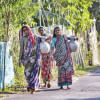Disaster management in Bangladesh: Reducing vulnerabilities
Bangladesh experienced over 200 natural disasters since 1980, leaving a total death toll of approximately 200,000 people and causing economic loss worth nearly $17 billion. Every year, we incurred 1.8 percent of GDP loss due to natural disaster. It is estimated that 14 percent of our GDP is exposed to disasters. After the devastating cyclone of 1991, the concept of response (acting after the occurrence) has been changed by the new concept of total disaster management (which includes response, recovery, rehabilitation and prevention, mitigation and preparedness). This is the genesis of observing National Disaster Preparedness Day. After the 1998 floods, the momentum increased significantly towards risk reduction. Such change or shifts are well ahead of many global initiatives.
In order to make disaster management system operative in an effective and efficient manner we have taken a lot of initiatives and we achieved significant success. The progress achieved can be of two categories mainly – the institutional framework and the legal and policy framework. Among the public sector institutions, the Ministry of Disaster Management and Relief, established in 1972, is the apex body, which currently focuses on the complete disaster management concept, and has taken shape as a separate ministry. The new concept is reflected in the allocation of business prioritising risk reduction as the centre of all activities.
The government has restructured and established the Disaster Management Department as the main organ or instrument in the field for implementing and coordinating various forms of disaster management activities. Merging two organisations – the Disaster Management Bureau (established after the 1991 cyclone) and the Directorate of Relief and Rehabilitation established earlier. For the dissemination of early warning signals of cyclones to the communities in the coastal zone, the Cyclone Preparedness Programme (CPP), a globally renowned volunteer organization of Bangladesh, which combines volunteerism and communication technology, was established in 1972, after the devastating Bhola cyclone. The organisation has been restructured and rejuvenated through training, technology upgrades (e.g. wireless network) and extension of the areas per the changing cyclone route.
Besides these reformed organisations, there are frontier organisations like the Bangladesh Metrological Department, Flood Forecasting and Warning Center, Water Development Board, Fire Service and Civil Defense. In the last couple of years, these organisations have also been strengthened significantly.
Research organizations like IWM WARPO, CEGIS, BUET, BCAS and others have also proven their increased capability.
The most demanded legal instrument was enacted in 2012 viz. the Disaster Management (DM) Act – incorporating existing orders, reforming institutions, envisaging new institutions, putting necessary mechanisms in place and making the disaster management system accountable with mandatory legal provisions. Before this Act, we worked under the Standing Order on Disaster (SOD) issued in 1997. It has two important features - provision of duties and responsibilities for the ministries and departments and secondly, the establishment of committees at all levels, considering the inter-relatedness of disaster management activities. This SOD is regarded as the "Bible of Disaster Management". Now these orders are part of the DM Act.
Currently we have other instruments like the Disaster Management Policy, approved by the cabinet, the Disaster Management Plan, guidelines also prepared for addressing specific disasters and purposes.
Understanding disaster and development related challenges, the General Economic Division incorporated a disaster and climate change action in the five year plan document (which started from the Sixth Five Year Plan). It's a tremendous achievement and is expected to guide the whole development process and quantify the results achieved with specific indicators. The Environment Ministry also prepared the Bangladesh Climate Change Strategy and Action Plan and National plan of Action.
Mortality reduction is the single most important result we achieved, as it reduced from 300,000 in 1970 to 3,000 in 2007. Food production increased three times in 1970. Poverty reduced from 40 percent in 2005 to 24.7 percent in 2014. Economic growth is averaging at 6 percent and is expected to increase. Five out of the eight goals were achieved under the Millennium Development Goals (MDGs). Literacy rate, sanitation coverage and women's participation are also mentionable achievements.
Against the backdrop of reforms done and the success achieved, we can claim justifiably that we are not afraid. But we must be aware about the present and future challenges. The changing patterns of disaster pose major challenges. We are better in managing rapid onset disasters like floods and cyclones. We have to agree that the intensity and frequency of natural disasters will increase with further climate change. On the other hand, we have no better understanding in managing slow- onset disasters, which include salinity, agricultural droughts and earthquakes. These disasters in the future may create insurmountable pressure on lives and livelihoods.
Unplanned urbanisation has been emerging as a major threat for us. Due to this process, many new disasters have already manifested. Urban congestion, fires, building collapses, pollution, urban flooding, etc. will be more frequent in the future.
Bangladesh, being a low deltaic country, is extremely vulnerable. Climate change has its impacts on every sector of the country's development. This will create complex and compound disasters. It is required to understand the change and its trend, and the dynamic and sustainable adaptation strategies. Longer term investments and strategies need to be developed.
Mainstreaming disaster and climate change issues in different sectors and in the development process are challenging tasks. Disaster and climate change is not an external issue – rather, it must be internalised by all sectors; otherwise, we shall not be able to overcome the odds successfully through just one ministry or department.
Human induced and technological disasters are getting more dominance in the landscape of disaster management. The role and engagement of the private sector is unquestionable. In our country, the matter to be considered is beyond the 'charity' mindset. Reduction of harmful consumption, production, distribution and deviant activities, attitudes and habits must be reduced. On the other hand, innovative ways need to be utilized to improve the disaster and climate change situation by producing and promoting new products and services. The other issue is short term versus long term investments, benefits, preparedness, planning and strategy. People here tend to prioritise short term benefits, but practitioners and academicians are always in favour of long term planning.
In the area of disaster management, Bangladesh is well ahead of many countries. This is why the country is considered a role model in managing natural disasters. The strength and attributes we have among others include community resilience, volunteerism, the Early Warning System, community based decision making process, government commitment, a vibrant NGO sector and an appreciable legal and institutional framework. These need to be strengthened further. Implementation of various provisions of legal and policy directives needs to be evaluated and further commitment is needed in this regard. Many provisions of the DM Act, especially the Disaster Management Fund, Volunteer Platform, Research and Training Institute, are to be put in place as priority activities. Educational and research organisations should be supported continuously.
This year is the beginning of three international interrelated processes – the Sendai Framework for Disaster Risk Reduction, the Agenda 2030 for Sustainable Development, and the COP21 Paris Agreement for climate change action. Bangladesh, as an active participating country, will once again prove to be the champion of disaster risk reduction through better preparedness at all levels and across all sectors, battling every type of disaster.
The writer is National Project Director, Comprehensive Disaster Management Programme (CDMP II).

 For all latest news, follow The Daily Star's Google News channel.
For all latest news, follow The Daily Star's Google News channel. 








Comments